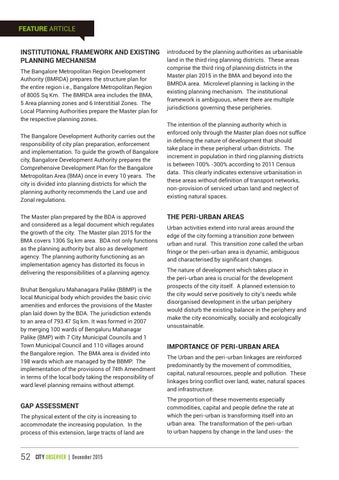FEATURE ARTICLE INSTITUTIONAL FRAMEWORK AND EXISTING PLANNING MECHANISM The Bangalore Metropolitan Region Development Authority (BMRDA) prepares the structure plan for the entire region i.e., Bangalore Metropolitan Region of 8005 Sq Km. The BMRDA area includes the BMA, 5 Area planning zones and 6 Interstitial Zones. The Local Planning Authorities prepare the Master plan for the respective planning zones. The Bangalore Development Authority carries out the responsibility of city plan preparation, enforcement and implementation. To guide the growth of Bangalore city, Bangalore Development Authority prepares the Comprehensive Development Plan for the Bangalore Metropolitan Area (BMA) once in every 10 years. The city is divided into planning districts for which the planning authority recommends the Land use and Zonal regulations. The Master plan prepared by the BDA is approved and considered as a legal document which regulates the growth of the city. The Master plan 2015 for the BMA covers 1306 Sq km area. BDA not only functions as the planning authority but also as development agency. The planning authority functioning as an implementation agency has distorted its focus in delivering the responsibilities of a planning agency. Bruhat Bengaluru Mahanagara Palike (BBMP) is the local Municipal body which provides the basic civic amenities and enforces the provisions of the Master plan laid down by the BDA. The jurisdiction extends to an area of 793.47 Sq km. It was formed in 2007 by merging 100 wards of Bengaluru Mahanagar Palike (BMP) with 7 City Municipal Councils and 1 Town Municipal Council and 110 villages around the Bangalore region. The BMA area is divided into 198 wards which are managed by the BBMP. The implementation of the provisions of 74th Amendment in terms of the local body taking the responsibility of ward level planning remains without attempt.
GAP ASSESSMENT The physical extent of the city is increasing to accommodate the increasing population. In the process of this extension, large tracts of land are
52
CITY OBSERVER | December 2015
introduced by the planning authorities as urbanisable land in the third ring planning districts. These areas comprise the third ring of planning districts in the Master plan 2015 in the BMA and beyond into the BMRDA area. Microlevel planning is lacking in the existing planning mechanism. The institutional framework is ambiguous, where there are multiple jurisdictions governing these peripheries. The intention of the planning authority which is enforced only through the Master plan does not suffice in defining the nature of development that should take place in these peripheral urban districts. The increment in population in third ring planning districts is between 100% -300% according to 2011 Census data. This clearly indicates extensive urbanisation in these areas without definition of transport networks, non-provision of serviced urban land and neglect of existing natural spaces.
THE PERI-URBAN AREAS Urban activities extend into rural areas around the edge of the city forming a transition zone between urban and rural. This transition zone called the urban fringe or the peri-urban area is dynamic, ambiguous and characterised by significant changes. The nature of development which takes place in the peri-urban area is crucial for the development prospects of the city itself. A planned extension to the city would serve positively to city’s needs while disorganised development in the urban periphery would disturb the existing balance in the periphery and make the city economically, socially and ecologically unsustainable.
IMPORTANCE OF PERI-URBAN AREA The Urban and the peri-urban linkages are reinforced predominantly by the movement of commodities, capital, natural resources, people and pollution. These linkages bring conflict over land, water, natural spaces and infrastructure. The proportion of these movements especially commodities, capital and people define the rate at which the peri-urban is transforming itself into an urban area. The transformation of the peri-urban to urban happens by change in the land uses- the
